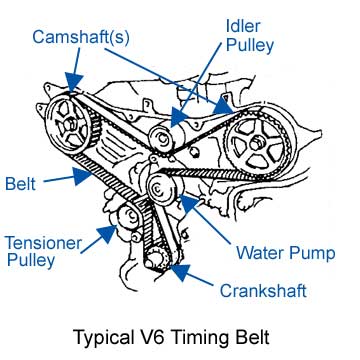Certain engines with overhead camshafts have
timing belts that have a limited life span. Car makers
use these belts instead of more durable chains because chains are
noisier and cost more to manufacture. Your vehicle owner's manual
will recommend at what mileage the timing belt must be replaced.
These intervals range from every 60,000 miles to every 105,000
miles.
Car makers
use these belts instead of more durable chains because chains are
noisier and cost more to manufacture. Your vehicle owner's manual
will recommend at what mileage the timing belt must be replaced.
These intervals range from every 60,000 miles to every 105,000
miles.
The job of the timing belt is to turn the
camshaft(s) at exactly 1/2 the speed of the crankshaft while
maintaining a precise alignment. This means that the crankshaft will
make two revolutions for every revolution of the camshaft. Engines
will have at least one camshaft, or as many as four camshafts in
some of the V-type engines. The camshaft causes the intake and
exhaust valves to open and close in time with the pistons which move
up and down in the cylinders. The valves must open and close at
exactly the right time in relationship to the piston movement in
order for the engine to run properly. For more information on how
this works, please read this article "How
an Engines Works".
There are two types of engines that use timing
belts. They are described as: "Interference Engines" and
"Non-interference Engines" The difference lies in the proximity
between the valves and the pistons. On an interference engine, if
the timing belt slips even one notch, the piston can crash into an
open valve causing serious engine damage by bending valves and
breaking pistons. Non-interference engines will usually not self
destruct, but in either case if the belt fails, the engine will
immediately shut down leaving you stranded. The link at the bottom
of this article will tell you which category your engine falls
under.
Timing belts fail without warning and on some
vehicles, are almost as hard to check as they are to change. In most
cases, your only protection is to change the belt at the recommended
intervals. Timing belt replacement is not a cheap job but it is far
less costly than the alternative.
Some technicians may recommend that you replace
the water pump during a timing belt job even if there is nothing
wrong with it. This is because 90% of the labor to change the water
pump has already been done with the timing belt job and some
technicians consider it good insurance to replace the pump at this
time. My feeling is that some water pumps can last the life of the
car but many do fail and will cost big money to replace at a later
date. So ask your technician what his experience is with the water
pump on your model car and look at how long you plan to keep the
car. This way, at least you will be making an informed roll of the
dice.

